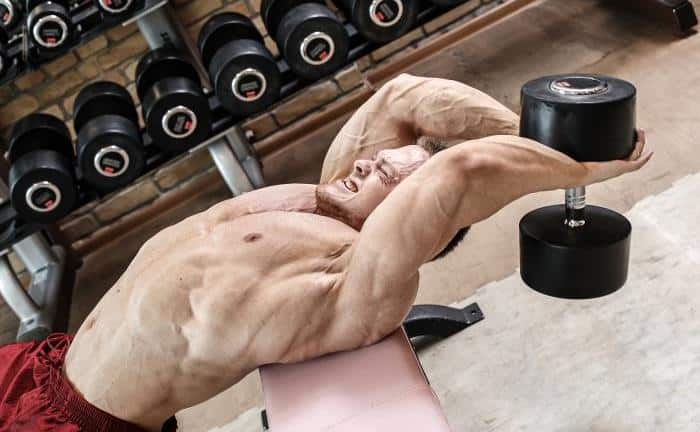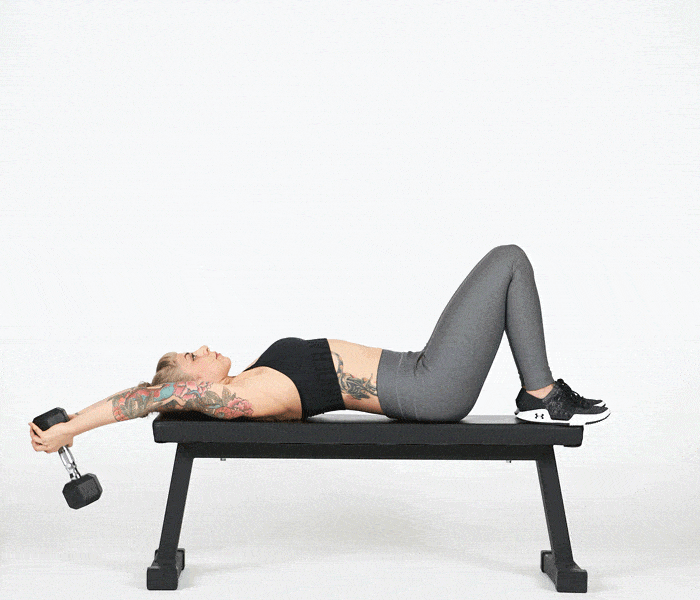
What are dumbbell pullovers?
What are dumbbell pullovers? If you are new to bodybuilding you may have heard of dumbbell pullovers but what are they, how do you perform them and what are the benefits of using them. This guide will tell you all that you need to know as well as answer the question 'what are dumbbell pullovers'?
The dumbbell pullover is a resistance exercise that targets muscles in the chest, shoulders and back. It is performed with a dumbbell and a dumbbell bench making it easy to perform in the majority of commercial and home gyms.
If you are looking to add mass to the upper body, especially the chest, add dumbbell pullovers into your routine. This article will tell you how to perform them, why they work and tips on how to get the most from the movement.
Which muscles are worked with dumbbell pullovers?

The dumbbell pullover is classed as a chest isolation exercise as the primary movers are the pectoral muscles. The lats, deltoids and triceps are secondary movers whilst the core and leg muscles act as stabilisers making it as good as a compound movement.
The main 'go to' movements when developing the pectoral muscles for mass or strength are generally a press or a fly. Adding pullovers to your routine will break down fibres that these traditional movements do not and allow for more growth.
How do I do dumbbell pullovers?
To perform dumbbell pullovers you will need a dumbbell, a dumbbell bench and a lot of space around you. Opt for light weight for the first set and pyramid your way up to your working sets. The dumbbell pullover requires an overextension of the arms and a big stretch so warming up properly is important. Jumping straight in with a big dumbbell can lead to rotator cuff, bicep, pectoral or back injuries.
- Set a dumbbell bench to a flat position and select your dumbbell from the rack.
- Lie sideways on the bench so that it is only supporting your upper back. Keep your feet in a wide stance for stability and use your legs to bridge the lower back.
- Lift the dumbbell above your head. Keeping the arms rigid, lower the weight behind your head so that you can feel your core, chest and shoulders stretching. This is your starting position.
- Take a deep breath. Upon exhale, raise the weight back up so that it is above your head. Do this with rigid arms so that you can feel your pectoral muscles taking the strain.
- Slowly lower the weight back behind your head and repeat for the required number of reps and sets.
Tips for a better dumbbell pullover.
- Don't try to do this movement after a heavy ab or leg session. There is a big stretch on the core and quads and you will not be able to perform the exercise to the best of your ability if you are suffering from DOMS or sore muscles.
- Allow your core to flex with the movement. It is just stabilising your upper back so it does not have to be too rigid. Slight movement of the core will allow you a better range of motion in the upper body.
- Make sure that nobody is working out behind you or that you have not left your phone on the floor behind you. If you are training heavy to failure, you may need to drop the weight on your last set without causing damage or injury to another person.
Alternatives to a dumbbell pullover.
Flat bench pullover.

The flat bench pullover is a variation of the traditional method. It does not allow the same stretch or range of motion but it still works the same muscles. This is a great option if you are new to the exercise or to working out in general. It can be performed on a flat bench or decline bench and you can use a barbell as an alternative to the dumbbell.
Cable Pullover
Another option is to use a cable machine for your pullovers. You will need to wheel a bench over to your cable machine, set the pulley to a low pin and clip on a rope attachment or straight bar. From here, the exercise is exactly the same as it would be if you are using a dumbbell.
the advantage of using a cable pulley instead of a dumbbell is the consistent resistance that it applies to the target muscles, There is no dead spot meaning your muscles get the maximum time under tension.
Weight Plate Pullover
The weight plate pullover is the same as a dumbbell pullover but it is performed with a weight plate instead of a dumbbell. Using a weight plate allows you to have a wider grip with your palms facing each other which can help if you have poor wrist mobility.
If you struggle with dumbbell pullovers, try using weight plates instead and see how you get on. Start with a small plate and pyramid up until you are confident with the weight that you can easily handle.
Conclusion
There you have it! A thorough explanation of the dumbbell pullover and all its benefits. This exercise is great for targeting your lats, as well as your chest and shoulders. It's a simple movement that can be performed with light or heavy weights, making it perfect for beginners and advanced fitness enthusiasts alike.
We hope that you have found this article useful and now have a better understanding of pullovers. Give the dumbbell pullover a try next time you're in the gym, and see how it can help you build a stronger, more muscular physique.
Check out our free hypertrophy training program for bodybuilders by clicking on this link. This scientifically-backed training strategy promotes maximum hypertrophy by training each muscle individually as soon as it has recovered from its previous workout. No waiting around for the next chest or leg day!

